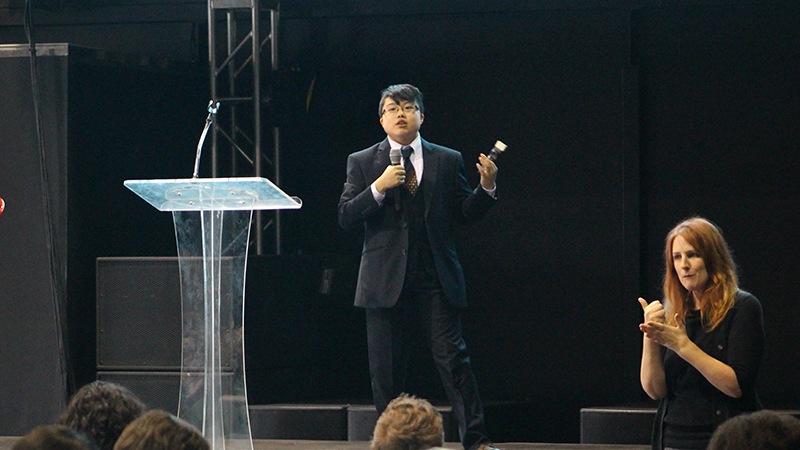Disability Justice at the Intersections
Leer en español
On Feb. 28, 2017, Lydia X. Z. Brown presented on inequities in health services for disabled people—with an intersectional focus on race, sexual orientation and gender identity—as part of The Trust’s Health Equity Learning Series. Photo by Rachel Mondragon
By Ned Calonge, MD, MPH
Lydia X. Z. Brown prefers that people speaking about them use the pronouns they and them, in order to not be misgendered. They are a gender queer, transracially and transnationally adopted East Asian autistic activist, writer and speaker.
To Brown, making room for all these intersecting elements of identity in each person’s life is crucial to fighting for justice.
As the latest speaker in The Trust’s Health Equity Learning Series, Brown focused on disability justice—which they described as a kind of quest to acknowledge and celebrate the complexity of each person’s mind and body, while understanding disability as a social and political force within a larger context of oppression.
Their presentation was given in Denver on Feb. 28, and will be integrated into a series of conversations hosted by organizations around Colorado in the coming weeks.
Brown helped break down the complex idea of disability justice with a grounding in the idea of “intersectionality.” That term, coined by scholar and activist Kimberlé Crenshaw, has gained popularity recently, and with good reason: It describes how the experience of a black woman is different from the experience of either a white woman or a black man, “and not simply understandable by adding one plus one,” said Brown.
Intersectionality helps us with an understanding of “what it means when any systems of oppression collide, of what it means to acknowledge privilege and oppression in the same sentence,” said Brown.
“For disabled people,” they continued, “the oppression that we live with is ableism.”
Ableism gives people who are considered “healthy” social and economic power compared with people whose bodies and brains “are labeled deviant, disordered, defective or diseased,” said Brown.
This doesn’t look the same for every disabled person, they added. The oppression experienced by a mentally disabled person is not the same as that experienced by someone with a physical disability, or with both. Likewise, the racism experienced by a light-skinned East Asian person is different from anti-black, anti-indigenous or anti-Latinx racism, said Brown.
But all these types of oppression support and depend upon each other. Throughout the past centuries in the U.S., many or most people who differ from the norms established to support the tenet of white, abled, heterosexual dominance have been categorized as less than, and often labeled as mentally ill or deviant—such as Africans who escaped from slavery and queer or non-monogamous women. “Ableism does not work without racism,” said Brown.
It’s in people’s individual stories that these academic concepts take on flesh and bone, and the results are violent and heartbreaking.
Brown told the story of Melissa Stoddard, an 11-year-old biracial autistic student who was killed by her stepmother, after authorities had received repeated reports of abuse.
More than 400 disabled people are known to have been murdered by their family members or caregivers in recent decades, said Brown.
Kayden Clarke, a white trans man who was also autistic and had psychiatric disabilities, was seeking gender-affirming surgery, but was told by a therapist that he couldn’t go forward until his autism was “cured.” Police were later called to his home because he was suicidal; they shot and killed him. He was misgendered in the initial media reports as “she.” “Even in death, how we tell stories reveals what we believe about who is valuable and worthy and desirable,” said Brown.
They also told the story of a black teenager with multiple disabilities who was gang-raped by a nearly all-white football team in a nearly all-white town, and whose attackers received no prison time. And of Neli Latson, a black teenager with autism whose trip to the library ended with his imprisonment and his institutionalization, after someone found him suspicious and called the police. And of Mel Baggs, a white, chronically ill, developmentally disabled activist who wrote about being discouraged by a medical provider from receiving life-saving treatment, and forced to endure surgery without anesthesia.
“This is the reality of disabled people at the intersections interacting with the systems that are supposed to care for us, that are supposed to support us, that in theory exist for the betterment of society,” said Brown. “This is why it is your imperative to integrate disability justice into your work. This is why.”
Brown continued: “In order to end white supremacy, in order to end the constant effects of incarceration, in order to end sexual violence, in order to end these things, we have to practice and honor disability justice.”